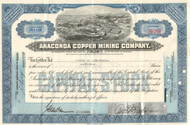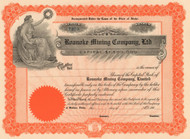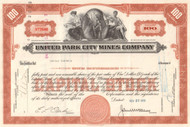Categories
Categories
- Home
- Mining and Oil
- Mining
- North Butte Mining Company 1930's (Montana copper mines)
North Butte Mining Company 1930's (Montana copper mines)
Product Description
North Butte Mining Company stock certificate 1930's
Wonderful Montana copper mining piece with great vignette of miners working underground. Smaller certificate measuring 7.5" by 11". Issued and cancelled. Dated 1930's and earlier.
In 1899 when the Anaconda Company's majority stock holdings were bought out by Standard Oil and placed in the holding company of the Amalgamated Copper Company, a number of smaller, interlocked companies were created. The North Butte Mining Company was among the most successful of the interlocked companies, and by 1910 employed 1,000 people. John D. Ryan (president of the Amalgamated) and his partner, Thomas Cole, controlled the properties of the North Butte Mining Company. Cole operated from Minnesota and Ryan operated from Butte, Montana. They appointed John D. Pope as general manager of the properties. Pope, a well known citizen of Butte, held a similar position with the Butte and Boston Mining Companies before becoming general manager of the North Butte Mining Company. Pope was in charge of the operation of the North Butte properties including Speculator, which was among the more important holdings.
The North Butte Mining Company, in Butte, Montana, was incorporated under Minnesota law on April 1, 1905, by Charles A. Duncan, Louis W. Powell, and Joseph B. Cotton. James Hoatson of Calumet, Michigan, was president of the company with Charles Duncan, Joseph Cotton, and Frederick R. Kennedy, all of Duluth, Minnesota, as officers and Arthur C. Carson as the first general manager.
In 1912 Thomas F. Cole replaced James Hoatson as president. He continued as president until 1919 when Robert Linton took over the presidency. Frederick R. Kennedy served as secretary-treasurer of the company from its inception until the late 1920s. Management of the mines in Butte was conducted by A.C. Carson until 1909 when operation was taken over by John D. Pope. In 1915 Norman B. Braly became general manager with Lester D. Frick as assistant manager.
In June, 1905, the company bought the properties of the Speculator Mining Company which had previously been owned by the P.A. Largey Estate. Among the properties acquired were the Speculator, Edith May, Jessie, Copper Dream, and Miner's Union claims. The company contracted with the Washoe Copper Company to process the copper ore, thus eliminating the need to expend large amounts of money building reduction and smelting facilities. The first year the mines produced over 30 million pounds of copper worth $5 million and paid dividends of $1 million, an almost unheard of amount for a new mining company. Production hit a peak in 1909 with 33 million pounds of copper and dividends of $1.6 million. By 1911 the investors' $6 million investment in stock had been paid off.
Development work pushed forward rapidly as well. Between the start of the company and 1920, development work averaged about 15,000 feet per year. In 1909 the North Butte purchased the Granite Mountain Mine from the Lewisohn Brothers interests. Over the next 5 years the Granite Mountain shaft was sunk from the initial 500 feet down to 2800 feet, the same level as the Speculator shaft. In 1915, the Granite Mountain shaft became the operating shaft, with the Speculator shaft being maintained as backup and as ventilation.
In 1913 the North Butte Mining Company acquired massive holdings in the East Side Mineral Area. This acquisition more than doubled the number of claims being worked by the company.
In 1915 the company suffered the first of two major disasters. On October 19, 1915, a portion of a shipment of dynamite was ignited accidentally on the surface next to the Granite Mountain shaft, killing 15 miners. On June 9, 1917 a spark ignited a fire at the 2300 foot level of the Granite Mountain shaft. Smoke from the fire quickly spread throughout the mine and approximately 160 miners lost their lives. Because of the joint operation of the Granite Mountain and Speculator mines, the disaster has always been known as the Speculator fire.
After the end of World War I, copper prices dropped dramatically. During the period of 1920 to 1923 the company was operating at a loss, and production was sharply curtailed. In March of 1921 production ceased and the mine closed until June of 1922. From then on the mine produced only sporadically, mostly through leasors. In 1942 the Anaconda Company leased the Speculator and Granite Mountain mines; around 1952 they purchased the property. Much of the company's east side property became part of the Berkeley Pit.
 Loading... Please wait...
Loading... Please wait... 








